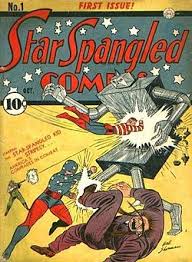October 1941 and the popularity of super-heroes in comics continues to rise. Many of the most popular heroes had made their debut the previous two years, but there were several to still come: Sargon the Sorcerer, Dr. Mid-Nite, Starman, Plastic Man, Phantom Lady, and Captain America have all been introduced earlier in the year. DC Comics added a new title to their stable this month, the first new anthology since World's Best/World's Finest in April of that year, and unlike that title, this one contained new features.
Star-Spangled Comics #1 was head-lined by the Star-Spangled Kid and Stripesy who were featured on the cover. In the leaf story, the Star-Spangled Kid and Stripesy take down a group of saboteurs attacking American defense factories. Neither the Star-Spangled Kid or Stripesy have powers. The hook lies in it being an inverted Batman type strip with the kid being the main hero and the adult being the sidekick, I was really stricken by how ahead of its time this felt. The strip, by Jerry Seigel and Hal Morris, had a humor and light-heartedness that is missing from a lot of Siegel's other work around this time, and the art by Hal Morris looked like a cross between Dick Sprang and Jerry Robinson, especially with the exaggerated grin and chin that is given to Stripesy. Siegel does humor, but its typically more biting and cynical.
The second strip was about an aviator, Captain X, who similar to Captain Desmo wears a super-hero style mask and colored costume, is an American reporter with a special plane, invisible and fast. He stops a Nazi plot to dam the English Channel so their troops can cross. I'll continue to read it if it continues on. The art is a little loose and not very stylized.
After Captain X is an arachnid themed hero with the ability to climb walls and a weapon that can be used to swing around and ensnare criminals. I'm not speaking of Peter Parker, but John Law, the Tarantula. John Law is a crime author who with his special boots and web gun, captures gang boss, Ace Deuce. It was a fun, fast-paced strip. I only know of the Tarantula from All-Star Squadron. Right now, he is very similar to the Sandman, who will later adopt a purple and yellow outfit very similar to the Tarantula. It will be interesting to see how the strip adapts if it is still around at that time. I skipped Armstrong of the Army, as I tend to only read the super-hero strips or those belonging to characters who made it into Who's Who.
Finally, the book closes with a second Star-Spangled Kid strip, which is unusual for an anthology of this time. Characters will appear in multiple titles, but unless they headline their own quarterly, not twice in the same issue. In the this installment, they defeat a rampaging robot, the creation of Dr. Weerd, a Dr. Jekyll and Mr. Hyde-type mad scientist. This was much like the first installment, light-hearted and breezy with large set pieces. Here it is the robot. All-in-all a good addition to the DC line-up. The Star-Spangled Kid never stood out for me in the few appearances I've read from the 70's All Star Comics run, but here, in his natural environment, I can see the appeal.

No comments:
Post a Comment